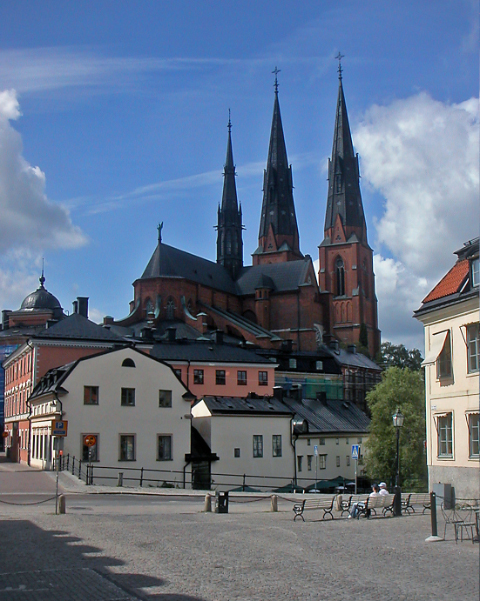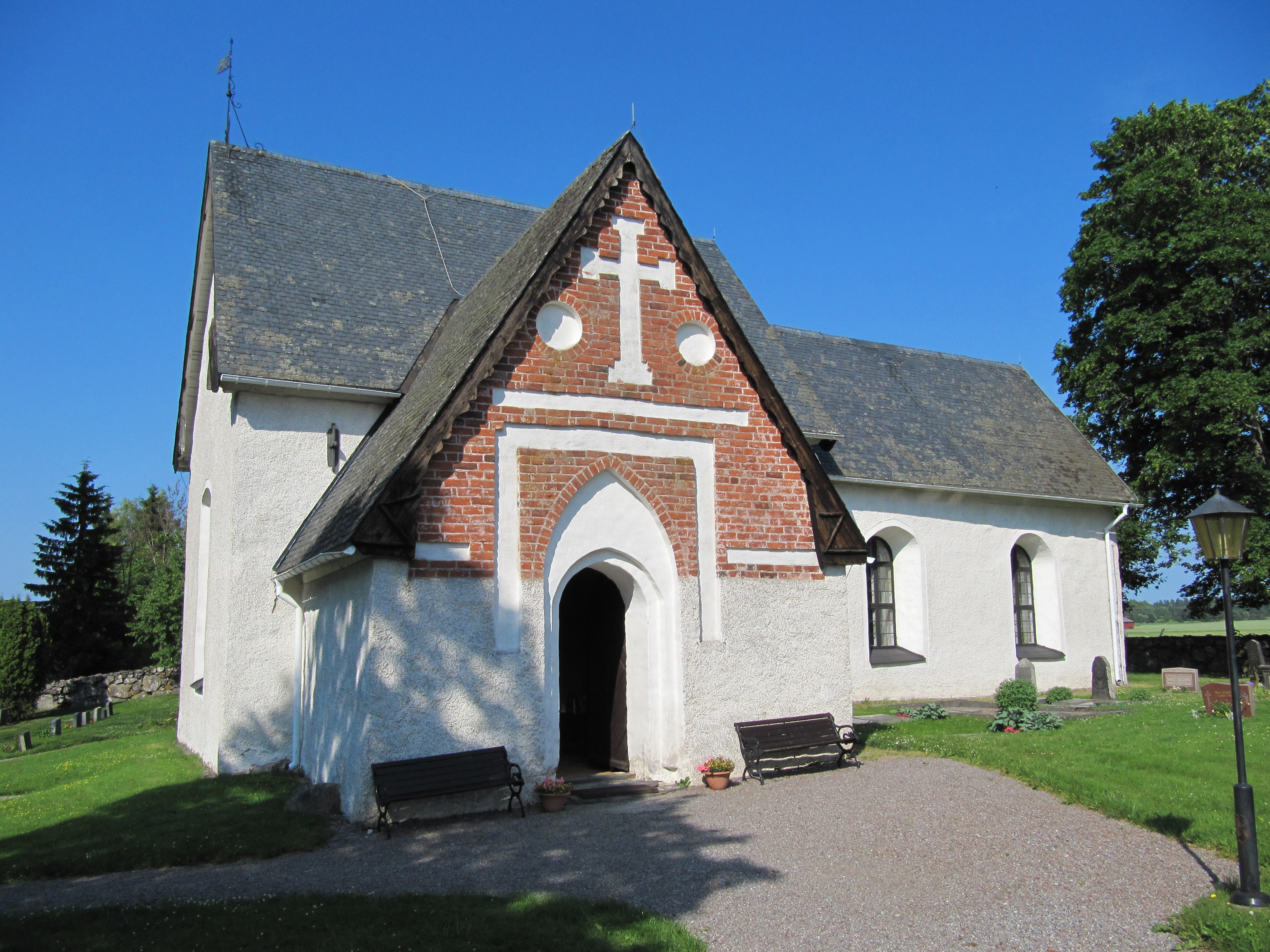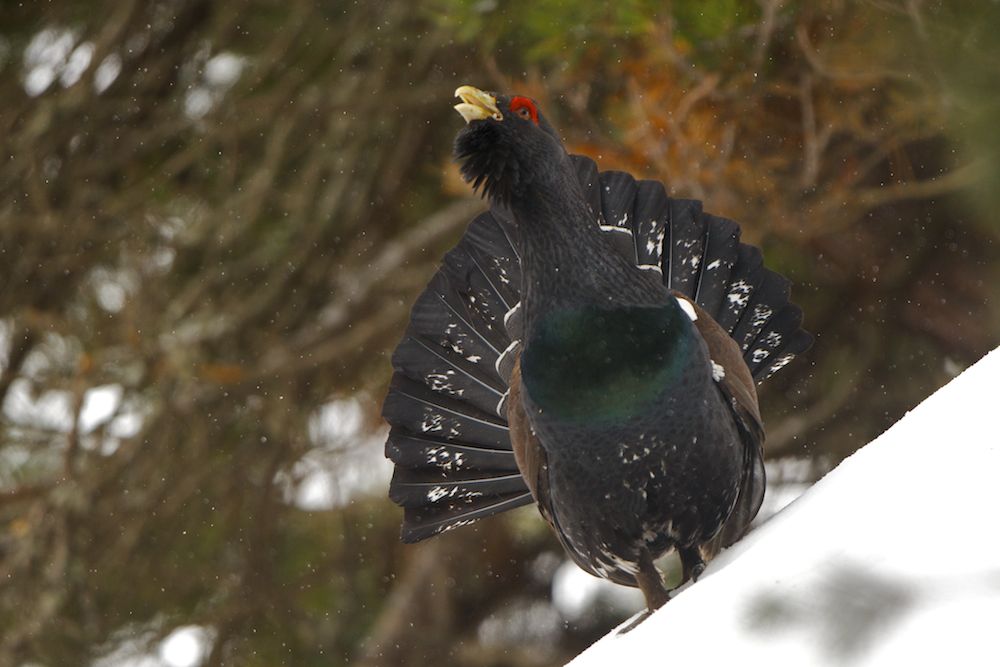|
Uppland Runic Inscription 448
This runic inscription, designated as U 448 in the Rundata catalog, is on a Viking Age memorial runestone located in Harg, which is about 4 kilometers north of Märsta, Stockholm County, Sweden, which was in the historic province of Uppland. Description The design of this inscription consists of runic text inscribed within a serpent band, which circles the stylized figures of a man on a horse and of a bird. The stone is composed of granite and is 1.9 meters in height. The inscription is tentatively classified as being carved in runestone style Pr3, which is also known as Urnes style. This runestone style is characterized by slim and stylized animals that are interwoven into tight patterns. The animal heads on Pr3 inscriptions are typically seen in profile with slender almond-shaped eyes and upwardly curled appendages on the noses and the necks. Based on stylistic analysis, the inscription has been attributed to the Swedish runemaster Fot, [...More Info...] [...Related Items...] OR: [Wikipedia] [Google] [Baidu] |
Thor
Thor (; from non, Þórr ) is a prominent god in Germanic paganism. In Norse mythology, he is a hammer-wielding æsir, god associated with lightning, thunder, storms, sacred trees and groves in Germanic paganism and mythology, sacred groves and trees, Physical strength, strength, the protection of humankind, hallowing, and fertility. Besides Old Norse , the deity occurs in Old English as , in Old Frisian as ', in Old Saxon as ', and in Old High German as , all ultimately stemming from the Proto-Germanic theonym , meaning 'Thunder'. Thor is a prominently mentioned god throughout the recorded history of the Germanic peoples, from the Roman Empire, Roman occupation of regions of , to the Germanic expansions of the Migration Period, to his high popularity during the Viking Age, when, in the face of the process of the Christianization of Scandinavia, emblems of his hammer, , were worn and Norse paganism, Norse pagan personal names containing the name of the god bear witness to his ... [...More Info...] [...Related Items...] OR: [Wikipedia] [Google] [Baidu] |
Uppsala Cathedral
Uppsala Cathedral ( sv, Uppsala domkyrka) is a cathedral located between the University Hall of Uppsala University and the Fyris river in the centre of Uppsala, Sweden. A church of the Church of Sweden, the national church, in the Lutheran tradition, Uppsala Cathedral is the seat of the Archbishop of Uppsala, the primate of Sweden. It is also the burial site of King Eric IX (c. 1120–1160, reigned 1156–1160), who became the patron saint of the nation, and it was the traditional location for the coronation of new Kings of Sweden. The current archbishop is Martin Modéus and the current bishop is Karin Johannesson. The cathedral dates to the late 13th century and, at a height of , it is the tallest church in the Nordic countries. Originally built under Roman Catholicism, it was used for coronations of Swedish monarchs for a lengthy period following the Protestant Reformation. Several of its chapels were converted to house the tombs of Swedish monarchs, including Gustav Vas ... [...More Info...] [...Related Items...] OR: [Wikipedia] [Google] [Baidu] |
Böksta Runestone
The Böksta runestone is a Viking Age memorial runestone that is located near the farm of Böksta in Balingsta, which is about four kilometers southwest of Ramstalund, Uppsala County, Sweden, in the historic province of Uppland. It is situated not far from Balingsta Church. Description The Böksta Runestone, which is made of granite and is 2.6 meters in height, is notable for its images of a man on horseback holding a spear who is hunting an animal that may be an elk (moose) with two dogs and two birds. One of the birds is attacking the eyes of the hunted animal, which is consistent with past practices when hunting with birds. Finds from graves indicate that falconry has been practiced in Sweden since the 6th century. Observing the hunter is another man on skis, holding a bow and arrow. Surrounding the hunting scene is the runic text inscribed within a serpent. The inscription is believed to date from approximately 1050 CE and is tentatively classified as being carved in runes ... [...More Info...] [...Related Items...] OR: [Wikipedia] [Google] [Baidu] |
Vidbo Runestones
The Vidbo Runestones are two Viking Age memorial runestones that are located in the churchyard of the Vidbo church, which is about east of Knivsta, Uppsala County, Sweden, in the historic province of Uppland. U 375 Uppland Runic Inscription 375 or U 375 is the Rundata catalog listing for a granite runestone that is 1.9 meters in height which consists of runic text carved in the younger futhark on two serpents which bracket a figure on a horse and a bird. Several other Scandinavian runestones include depictions of horses, including DR 96 in Ålum, N 61 in Alstad, Sö 101 in Ramsundsberget, Sö 226 in Norra Stutby, Sö 239 in Häringe, Sö 327 in Göksten, U 488 in Harg, U 599 in Hanunda, U 691 in Söderby, U 855 in Böksta, U 901 in Håmö, U 935 at the Uppsala Cathedral, and U 1003 in Frötuna. The two serpents have fetters around their necks and, near the bottom of the inscription, their tails, perhaps intended to bind them to the stone. The runic text is read clockwise ... [...More Info...] [...Related Items...] OR: [Wikipedia] [Google] [Baidu] |
Södermanland Runic Inscription 226
Södermanland Runic Inscription 226 or Sö 226 is the Rundata catalog listing for a Viking Age memorial runestone located in Norra Stutby, which is about eight kilometers north of Sorunda, Stockholm County, Sweden, which was in the historic province of Södermanland. Description The inscription on Sö 226 consists of runic text in the younger futhark that is carved on a serpent that circles along the outline of the stone, which is about 1.8 meters in height. A figure of a horse is in inside the serpent at the top of the stone. The horse, which is clearly a stallion as indicated by the phallus, is depicted with crossed legs to indicate powerlessness. The combination of symbols of fertility and powerlessness on the horse may indicate regeneration or salvation. Several other Scandinavian runestones include depictions of horses, including DR 96 in Ålum, N 61 in Alstad, Sö 101 in Ramsundsberget, Sö 239 in Häringe, Sö 327 in Göksten, U 375 in Vidbo, U 488 in Harg, U 599 in ... [...More Info...] [...Related Items...] OR: [Wikipedia] [Google] [Baidu] |
Sigurd Stones
The Sigurd stones form a group of eight or nine Swedish runic inscriptions (five or six runestones, two natural rocks, and a baptismal font) and one picture stone that depict imagery from the Germanic heroic legend of Sigurd the dragon slayer. They were made during the Viking Age and constitute the earliest Norse representations of the matter of the Völsung cycle that is the basis of the Middle High German ''Nibelungenlied'' and the Sigurd legends in the ''Poetic Edda'', the ''Prose Edda'', and the ''Völsunga saga''. In addition, the figure of Sigurd sucking the dragon's blood from his thumb appears on several carved stones in parts of Great Britain that were under Norse culture: at Ripon and Kirby Hill, North Yorkshire, at York and at Halton, Lancashire, and carved slates from the Isle of Man, broadly dated , include several pieces interpreted as showing episodes from the Sigurd story. Uppland U 1163 This runestone is in runestone style Pr2. It was found in Drävle, bu ... [...More Info...] [...Related Items...] OR: [Wikipedia] [Google] [Baidu] |
Ålum Runestones
The Ålum Runestones are four Viking Age memorial runestones which are located at the church in Ålum, which is west of Randers, Denmark. One of the stones refers to a man with the title drengr and two of the other stones were raised by the same family. Ålum 1 The inscription on Ålum 1, listed as DR 94 in the Rundata catalog, consists of several lines of runic text in the younger futhark on the face of a granite stone in height. The inscription is classified as being carved in runestone style RAK, which is considered to be the oldest classification. This is the classification for inscriptions where the runic text bands have straight ends without any attached serpent or beast heads. The runestone was discovered in 1843 broken into three sections and used in the southeast corner of the church porch. Prior to the understanding of the historic significance of runestones, there were often re-used in the construction of roads, bridges, and buildings such as churches. The sections ... [...More Info...] [...Related Items...] OR: [Wikipedia] [Google] [Baidu] |
Scandinavia
Scandinavia; Sámi languages: /. ( ) is a subregion#Europe, subregion in Northern Europe, with strong historical, cultural, and linguistic ties between its constituent peoples. In English usage, ''Scandinavia'' most commonly refers to Denmark, Norway, and Sweden. It can sometimes also refer more narrowly to the Scandinavian Peninsula (which excludes Denmark but includes part of Finland), or more broadly to include all of Finland, Iceland, and the Faroe Islands. The geography of the region is varied, from the Norwegian fjords in the west and Scandinavian mountains covering parts of Norway and Sweden, to the low and flat areas of Denmark in the south, as well as archipelagos and lakes in the east. Most of the population in the region live in the more temperate southern regions, with the northern parts having long, cold, winters. The region became notable during the Viking Age, when Scandinavian peoples participated in large scale raiding, conquest, colonization and trading mostl ... [...More Info...] [...Related Items...] OR: [Wikipedia] [Google] [Baidu] |
Western Capercaillie
The western capercaillie (''Tetrao urogallus''), also known as the Eurasian capercaillie, wood grouse, heather cock, cock-of-the-woods, or simply capercaillie , is a heavy member of the grouse family and the largest of all extant grouse species. The heaviest-known specimen, recorded in captivity, had a weight of . Found across Europe and the Palearctic, this primarily-ground-dwelling forest grouse is renowned for its courtship display. This bird shows extreme sexual dimorphism, with males nearly twice the size of females. The global population is listed as "least concern" under the IUCN, although the populations of central Europe are declining and fragmented, or possibly extirpated. The western capercaillie is one of two living species under the genus ''Tetrao'', which also includes the lesser-known black-billed capercaillie. Etymology The word ''capercaillie'' is a corruption of the Scottish Gaelic ''capall coille'' () "Horse of the jungle". The Scots borrowing is spelled ''cap ... [...More Info...] [...Related Items...] OR: [Wikipedia] [Google] [Baidu] |
Black Grouse
The black grouse (''Lyrurus tetrix''), also known as northern black grouse, Eurasian black grouse, blackgame or blackcock, is a large game bird in the grouse family. It is a sedentary species, spanning across the Palearctic in moorland and steppe habitat when breeding, often near wooded areas. They will spend the winter perched in dense forests, feeding almost exclusively on the needles of conifers. The black grouse is one of 2 species of grouse in the genus '' Lyrurus'', the other being the lesser-known Caucasian grouse. The female is greyish-brown and has a cackling or warbling call. She takes all responsibility for nesting and caring for the chicks, as typical with most galliforms. The black grouse's genome was sequenced in 2014. Taxonomy and naming The black grouse was formally described by the Swedish naturalist Carl Linnaeus in 1758 in the tenth edition of his ''Systema Naturae'' under the binomial name ''Tetrao tetrix''. Both ''Tetrao'' and ''tetrix'' come from Ancie ... [...More Info...] [...Related Items...] OR: [Wikipedia] [Google] [Baidu] |






